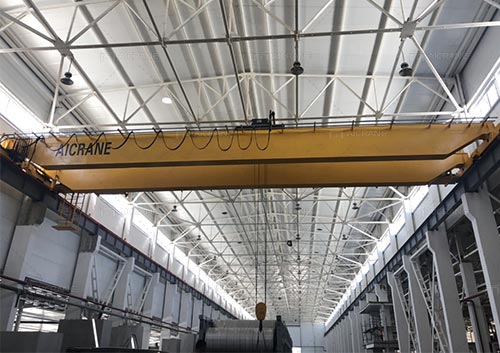


Here we will delve into the key components and structural design features of top running cranes to better understand their functionality and performance.
Top running cranes, also known as bridge cranes, are essential in industries where heavy materials need to be lifted and moved across a facility. These cranes are designed to provide efficient, high-capacity lifting, typically found in warehouses, factories, and construction sites. In this article, we will explore the key components and structural design features of top running cranes to better understand how they work and their advantages.
A top running crane consists of several critical components, each with a specific function:
Bridge (or Girder): The bridge is the horizontal beam that supports the crane’s movement across the tracks. It can either be a single girder or double girder. Double girder cranes are stronger and allow for higher lifting capacities, while single girder cranes are typically used for lighter loads.
Trolley: Mounted on the bridge, the trolley moves horizontally and carries the hoist system, which raises and lowers the load. The trolley ensures precise movement across the crane’s span.
Hoist: The hoist is responsible for lifting and lowering the load. It is mounted on the trolley and typically uses a wire rope and drum system for this purpose.
Runway Beams: These beams are installed along the sides of the crane’s travel path. They provide a stable track for the crane’s bridge and trolley to move along, supporting the crane’s weight and the load it carries.
End Trucks: These trucks are mounted at both ends of the bridge. They house the wheels that allow the crane to move along the runway beams, ensuring smooth travel across the entire span.
The design of top running cranes focuses on strength, stability, and efficiency. Several factors must be carefully considered in the crane’s structural design:
Load Capacity: The crane must be strong enough to lift the required loads without compromising safety. Double girder cranes, which have two parallel beams, are ideal for heavy-duty applications because they provide greater load distribution and stability.
Span and Lifting Height: The span refers to the distance between the runway beams, and the lifting height is how far the hoist can raise a load. These dimensions are critical to the design, as they determine how much space the crane needs and the types of materials it can handle.
Material Strength and Durability: Steel is the most common material used in top running cranes due to its high strength and resistance to fatigue. The crane’s components must be designed to endure the stresses of regular use, including heavy lifting and dynamic forces from acceleration and deceleration.
Stability and Safety: Safety is a top priority. The crane’s design must ensure that all parts are securely mounted to prevent instability. Features like anti-sway mechanisms, limit switches, and emergency stops are often integrated into the design to enhance safety during operation.
Motion and Alignment: Proper alignment of the tracks, wheels, and trolley system is essential for smooth operation. Misalignment can cause excessive wear and reduce the crane’s lifespan.
The structural design of top running cranes offers several key advantages that make them ideal for industrial applications:
High Load Capacity: Double girder overhead cranes, in particular, provide superior lifting capabilities and can handle heavy loads over long distances, making them suitable for demanding applications in manufacturing, construction, and logistics.
Space Efficiency: Since the crane runs on overhead tracks, it maximizes available floor space, allowing for other equipment or operations beneath the crane. This design is especially useful in facilities with limited floor space.
Smooth Operation: Top running cranes are designed for smooth, precise movement, which is important for operations requiring accurate load placement, such as in assembly lines or material handling.
Durability: Built with strong materials like steel and designed to withstand the wear and tear of heavy-duty operations, top running cranes offer long-lasting, reliable performance.
The structural design of top running cranes is a balance of strength, stability, and efficiency. Understanding the key components—such as the bridge, trolley, hoist, runway beams, and end trucks—and how they work together is crucial for maximizing crane performance. Whether used for light-duty or heavy-duty applications, the structural design ensures that top running cranes are safe, efficient, and capable of handling heavy loads with precision.
